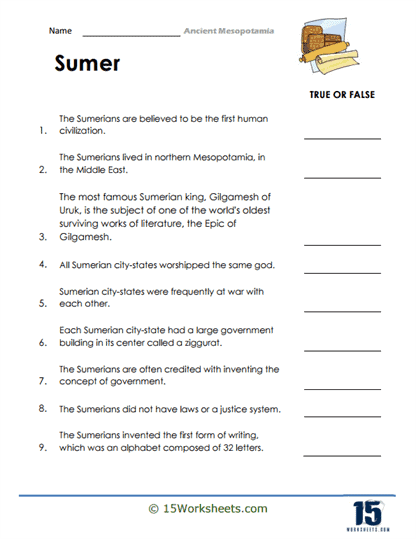True and False

Worksheet Description
This worksheet will have you evaluate a series of statements about Ancient Mesopotamia and ask you to determine if the statements are facts or falsities.
Here are 5 Ancient Mesopotamia facts for you:
Cradle of Civilization – Ancient Mesopotamia, located in the region of the Tigris and Euphrates rivers in modern-day Iraq, Syria, and Turkey, is often referred to as the “Cradle of Civilization.” It was here that some of the world’s first cities, such as Uruk, Ur, and Babylon, were established around 4500 BCE, marking the transition from nomadic to urban societies.
Invention of Writing – The Sumerians, who inhabited southern Mesopotamia, developed the world’s first known writing system, called cuneiform, around 3200 BCE. This system used wedge-shaped marks made on clay tablets to represent words or syllables, allowing for record-keeping, administration, and communication across long distances.
Early Legal Codes – Ancient Mesopotamia saw the development of some of the world’s first legal codes. The most famous of these is the Code of Hammurabi, created by the Babylonian king Hammurabi around 1754 BCE. This comprehensive set of laws covered a wide range of topics, from property rights to trade and family law, and was inscribed on a large stone stele for public display.
Ziggurats and Temples – Mesopotamians built massive stepped pyramids called ziggurats as religious centers and homes for their gods. These structures, made from mud bricks, served as the focal point of religious life and were often part of larger temple complexes. The most famous ziggurat is the Great Ziggurat of Ur, built around 2100 BCE.
Innovations in Science and Technology – Ancient Mesopotamians made significant advancements in various fields, such as mathematics, astronomy, and medicine. They developed a sexagesimal (base 60) number system, which is the basis for the modern measurement of time and angles. Additionally, they created lunar calendars and made detailed observations of celestial bodies, paving the way for later astronomical discoveries.
